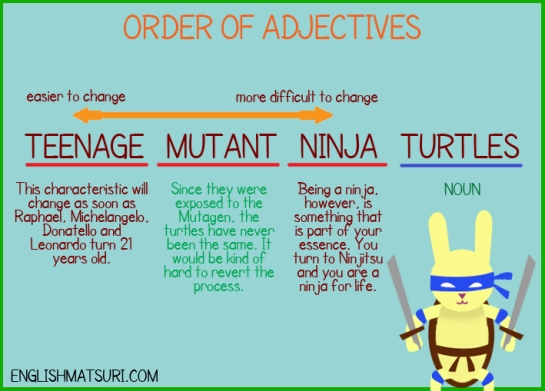¡TENGAN TODOS UN DÍA MUY TUBULAR! Me queda difícil pensar en una mejor forma para desearles un buen día. ¿Recuerdan quiénes usaban esa expresión? Exacto: las Tortugas ninja adolescentes mutantes (Teenage Mutant Ninja Turtles ®). Cuando era niño era un admirador embebido de las tortugas ninja. Hace poco descubrí que ellas tienen la clave para explicar el orden de los adjetivos en el idioma inglés.
¿Qué viene primero?
Piensa en una persona a la que verdaderamente quieres mucho. Puede ser tu mamá, tu papá, algún familiar, tu pareja o un personaje que sea una inspiración. ¿Podrías describirle con un solo adjetivo? (Recuerda que los adjetivos son palabras que modifican a los sustantivos describiendo sus características y cualidades) Sería muy difícil, ¿Verdad? Por ejemplo, sobre mi hermana yo diría que ella es tenaz (resilient), pero también es recursiva (resourceful) , e inteligente (intelligent). Y graciosa (funny). De querer poner todas estas virtudes de la primogénita de mi casa paterna en una frase, ¿Cómo podría hacerlo?
My sister is a resilient, resourceful, intelligent and funny woman?
(¿Mi hermana es una mujer tenaz, recursiva, inteligente y graciosa?)
My sister is a resourceful, intelligent, funny and resilient woman?
(¿Mi hermana es una mujer recursiva, inteligente, graciosa y tenaz?)
My sister is an intelligent, funny, resilient and resourceful woman?
(¿Mi hermana es una mujer inteligente, graciosa, tenaz y recursiva?)
Pues bien, si observamos a las Tortugas ninja adolescentes mutantes (Teenage Mutant Ninja Turtles ®) encontraremos la respuesta.
Los adjetivos que vienen antes de la cosa que estás describiendo siguen este orden en inglés: lo primero que mencionas es ya una opinión subjetiva o ya la característica que puede cambiar más fácilmente. En el caso de las tortugas, se trata de “Teenage” (adolescentes) porque en un par de años se convertirán en las “Adult Mutant Ninja Turtles” (Tortugas ninja adultas mutantes) y a nadie le interesará eso. En el caso de mi hermana lo primero que mencionaré será “Funny” (graciosa) porque es mi opinión. Otras personas pueden pensar que es tan agria como la crema agria que le pones a los burritos (mmm, burritos). El adjetivo más cercano al sustantivo es la característica más difícil de alterar o que es inherente a la cosa que estás describiendo. Volviendo al cuento, en el caso de las tortugas sería “Ninja” –aunque no sea un adjetivo en el sentido estricto sino un sustantivo haciendo las veces de un adjetivo- la palabra más cercana al adjetivo. Ser ninja es algo en lo que te conviertes y que nunca dejas de ser. Aún si se vuelven ancianas y promedio, seguirán siendo las Tortugas ninja. Cuando hablamos de mi hermana, es mi parecer que “inteligente” es la que se halla junto al sustantivo; ha demostrado serlo a lo largo de los años y mucha gente con la que ha trabajo puede dar fe de ello. Así que su descripción sería como se muestra a continuación à
My sister is a funny, resourceful, resilient and intelligent woman.
(Mi hermana es una mujer ointeligente, recursive, tenaz y graciosa).
Mantén presente esta sencilla regla y podrás utilizar los adjetivos en inglés de una forma más eficiente. Sólo por practicar, ¿Por qué no intentas describir una persona que sea importante para ti en una oración llena de adjetivos en la sección de comentarios?
Espero poder leer tu contribución.
______*__*__*_______
Addendum
Ayer vía Twitter, el usuario y entusiaste del lenguaje @ratapaloma_ compartió una maravillosa mnemotecnia para recordar el orden correcto de los adjetivos calificativos en inglés. Sólo recuerden estas palabras: OSAS COMUN, Es un acrónimo de Opinion (opinión), Size (tamaño), Age (edad), Shape (forma), Color (color), Origin (procedencia), Material (material), Usage (uso) y Noun (sustantivo). Mantén las palabras en ese orden y no podrás equivocarte. 🙂


